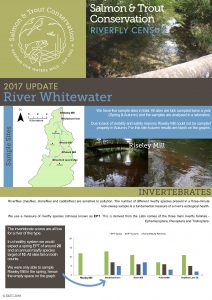The Whitewater Valley Preservation Society (WVPS) has been engaged by South East Water as a consultee in the production of the last two 5-year Water Resource Management Plans. The Society has actively been involved with the Environment Agency and Natural England in the implementation of the Water Framework Directive and the production of the Loddon Catchment Management Plans. We also campaigned for the river during Catchment Abstraction Management Strategy reviews and subsequent Restoring Sustainable Abstraction programmes, which finally resulted in a decision by Natural England that South East Water could no longer assume long term abstraction from the Greywell source.
The River Whitewater may look clean and beautiful but appearances can be deceptive. Clear does not necessarily mean healthy.

WVPS, in conjunction with Salmon & Trout Conservation UK, selected 5 locations suitable for their Riverfly survey, from the source at Greywell to the confluence with the Blackwater at Riseley.
The detailed results were analysed at a laboratory and a series of charts produced, using data collected from other chalk streams to suggest conclusions which could be drawn from those comparisons.
Invertebrate scores in the Whitewater are all low for a river of this type:
- EPT scores – Ephemeroptera (up-winged flies), Plecoptera (stoneflies) and Trichoptera (caddisflies) – should be around 20, but the highest is 13, and one location scores only 6.
- Annual Mayfly species should score 10 but the actual scores were 7, 5, 3, 2 and 1.
Biometric measures use the different sensitivities of aquatic insects to subtle, but lethal, impacts from: sediment, phosphate, organic enrichment and river flow. Species level analysis provides a measure of the impact of these pollutants at each site:
- Results show that most sites exhibit sediment pressure in Spring and Autumn.
- Phosphate issues are more pronounced in the Autumn and are at or above the line of concern at two sites (Deptford Lane Bridge and Holdshott Farm).
- Organic Enrichment from slurry and possibly untreated effluent is visible at all sites.
- Autumn results reflect the impact of lower flows concentrating the sediment and phosphate load, although the Spring results are not much better.
The full WVPS 2017 Riverfly Survey final report includes a map showing sampling sites, and Appendix showing in more detail the 10 measures of ecological status used to analyse each sample.
